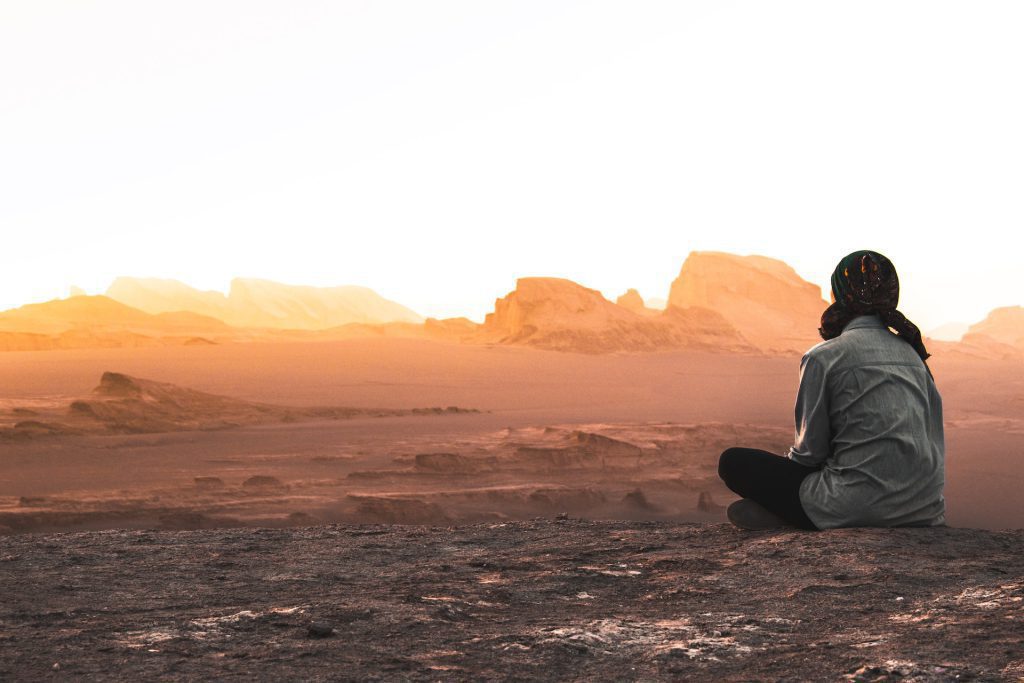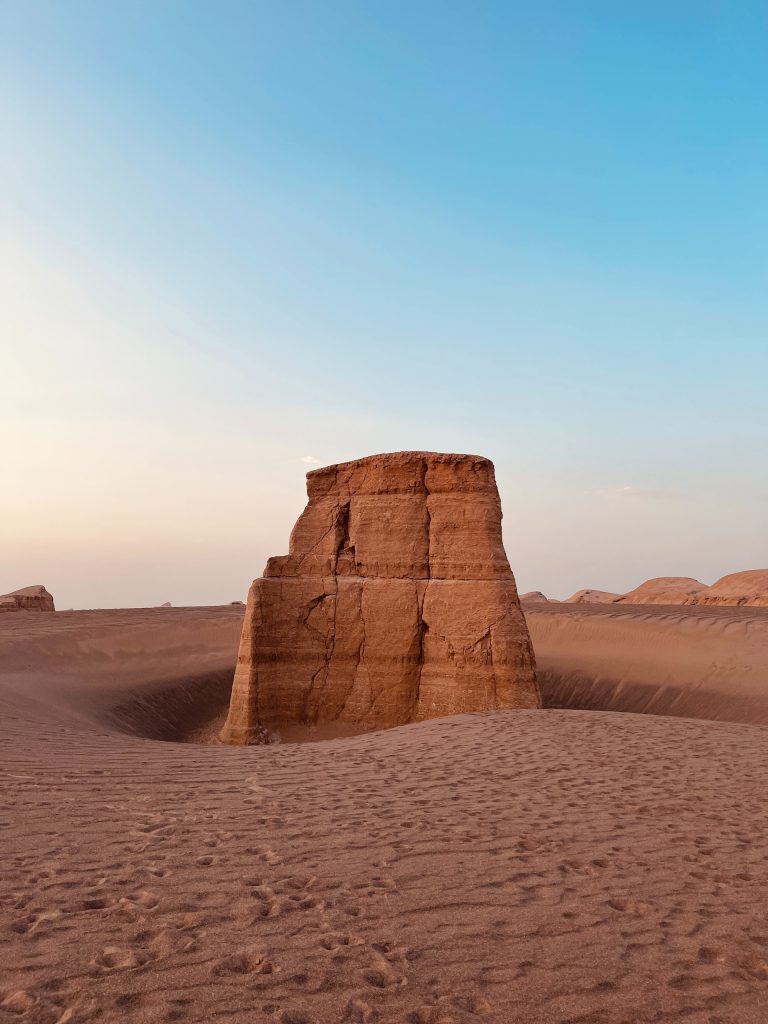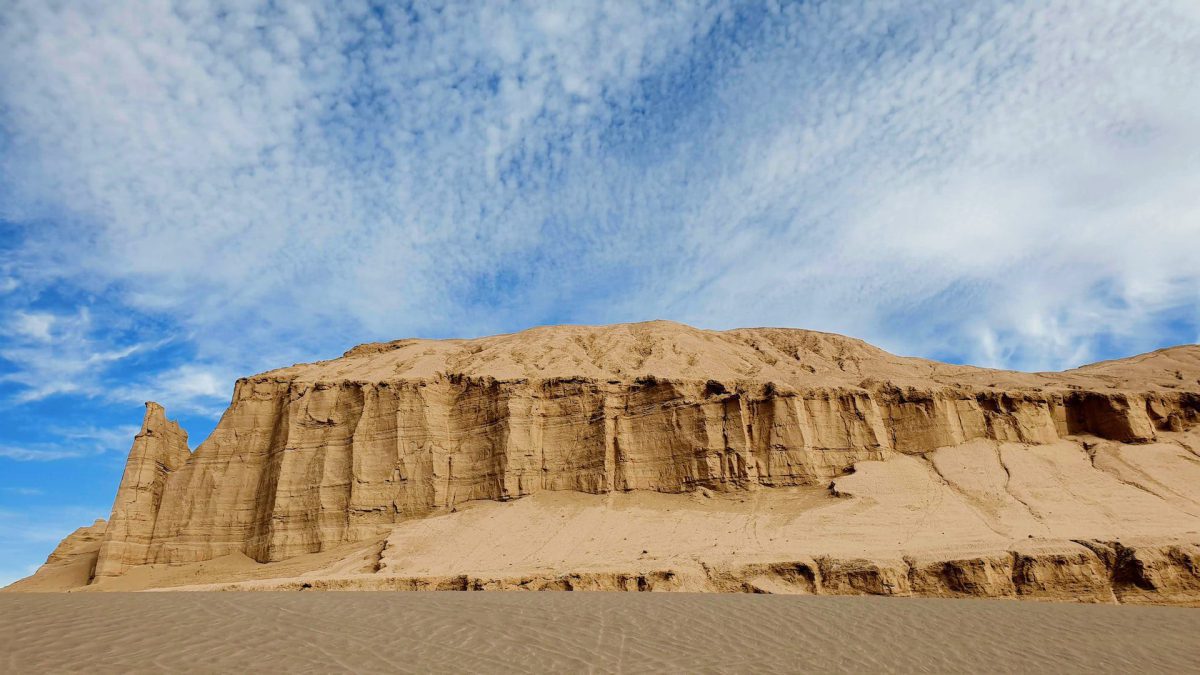Table of Contents
The Dasht-e Lut, known as the Lut Desert, is a place that boasts natural wonders that offer visitors a unique experience. To see the natural wonders of the Lut Desert, you need to travel to southern Iran where its never-ending dunes and plains, present a breathtaking sight under a clear sky. Although it is known to be one of the hottest places on the planet, with temperatures reaching a maximum of 70°C (158°F), the Lut Desert is home to a unique ecosystem. The stunning yellow corrugated ridges of the Lut hide seasonal rivers and also rare birds, lizards, and insects.
The Lut Desert Iran features a captivating scenery that makes it a perfect destination for tourism, adventure tourism, and cultural tourism. Visitors will have a chance to appreciate the beauty of the yellow sandstone formations that are a result of years of erosion by the wind. This magnificent natural creation, together with seasonal rivers, forms a magical scenic view that ignites one’s adventurous spirit. With such a long history dating back to 7000 years, the desert is also a treasure trove of cultural heritage, making the place perfect for cultural tourism.
Lut Desert Temperature
In the heart of the Lut Desert, there’s a spot surrounded by tall mountains. These mountains create a natural shield, making this place incredibly dry – so dry that it’s almost otherworldly. Imagine a land where rain is a rare visitor, and the sun rules the sky relentlessly, baking the ground below.
This unique desert is no stranger to heat. Here, temperatures climb to astonishing heights, breaking records and leaving a lasting impression on anyone who ventures here. Picture a place where the ground feels like it’s on fire, the air shimmers with heat waves, and even breathing becomes a challenge. In this scorching furnace, a mind-boggling temperature of 70.7°C (159.3°F) was once recorded for Dasht e Lut weather, marking it as one of the hottest spots on Earth. It’s not just a number; it’s a powerful reminder of the incredible forces nature holds, shaping the remarkable landscape of the desert.
The Enchanting Beauty of Lut Desert’s Shur River
The Lut Desert, also known as Dasht-e Lut, is a remarkable natural wonder located in the southeast of Iran across three provinces; Kerman, Sistano Baluchestan, and Khorasan-e Jonubi. With a core zone of 23,000 square kilometers and a protected buffer zone of 18,000 square kilometers, the desert boasts stunning and diverse landscapes such as the Rig-e Yallan sand dunes, Kalut yardang, Nebka depressions, Shur river, Gandom Beryan plateau covered with dark lava, and the central Hamada desert pavement.
The unique geomorphological features of the desert are a result of the severe temperatures that regularly reach up to 70°C. The daily temperature heat decomposes rock outcrops in the mountains, which then get deposited on the Hamada plain in the central part of the desert. The plain has a reverse triangular shape pointing towards the south where the Shurgaz Hamun playa is situated. Another intriguing feature of the Lut Desert is the Shur River, which flows along a 2000-kilometer-long stretch, starting from the Ravar Mountains to the west margin of Gandom Beryan into the salt depression. The presence of the river in the midst of the arid desert adds to its distinctiveness and makes it even more alluring.

The desert, with its vast and varied landscapes, unique features, and extreme weather conditions, is a perfect destination for adventure seekers, nature lovers, and photographers. This incredible natural wonder sets itself apart with its scorching temperatures and fascinating geological formations, making it a true testament to the wonders of nature. The desert is not just a desert, it is a mesmerizing and mysterious work of art created by nature itself.
The Mystery Behind Kalut: Exploring the Enigmatic Landscape Formation
Kalut or yardang, as it is known in Persian, is a fascinating and enigmatic landscape formation in the Dasht-e Lut desert of southeastern Iran. The word Kalut is derived from the Persian word “kalate,” which means a town or village surrounded by desert. However, it is not a town or village, but rather a unique geological feature shaped by the forces of nature over millions of years.
The formation of Kalut is a result of the vaporization of a sea that once existed in this part of Iran. Over time, the rivers that flowed from north to south eroded the soil and created canyons between them, while the harsh north-to-south winds carved yardangs into the soft rock formations. These yardangs are immense, with some standing as high as 155 meters and spreading across a vast area of 80×140 square kilometers. Such is their size that they can even be seen from space.
Despite the vastness and harsh conditions, Kalut remains a stunning sight to behold. Visitors are left mesmerized by the unique formations that stand as a testament to the incredible power of nature. Although the mystery behind Kalut’s creation continues, the site remains one of the most fascinating geological wonders in the world.

The Astronomical Wonders of Lut Desert
The Lut Desert is not just a stunning natural wonder but also holds great geological importance. The desert’s landform evolution over the Quaternary period tells a unique story of geological and geomorphological transformations. The rich geological history of the Lut Desert in Iran, accompanied by its culturally significant communities, grants this region a special place in the world’s natural and cultural heritage.
The Lut Desert boasts several unique and spectacular natural features, including the world’s highest sand dunes that rise over 475 meters in Rig-e Yallan. The desert is also home to the highest Kalutes (yardangs) on Earth, standing over 155 meters tall. These yardangs are so extensive that they can be viewed from space, making them a popular attraction for tourists and photographers alike. Moreover, in 2005, NASA recorded more than 70°C in the southwest of Rig-e Yallan, making it the hottest spot on Earth.
The Lut Desert’s geological and cultural significance, coupled with its natural beauty, makes it a must-visit destination for travelers, researchers, and nature enthusiasts. The ever-changing landforms of the desert hold many surprises, and its archeological treasures continue to unearth stories of civilizations from long ago.
The Magnificence of Lut Desert’s Cultural Landscape
The Lut Desert not only impresses us with its stunning natural wonders but also gives us a glimpse into the history of human civilization. The western fringe of the desert, known as the Shahdad Plain, is of particular importance to Near Eastern archeology. Shahdad was a crucial trading post on the ancient ‘silk road’ connecting the Persian Gulf seaports to Middle Asian and distant regions in the East and West from 1000 years ago.
Human beings have been living in the Lut Plain region for more than 7000 years, dating back to the 5th millennium B.C. The Shahdad Plain, despite being in proximity to the arid and hot desert, was chosen by the ancient inhabitants as their place of living. Archaeological evidence reveals that the region is home to over 7000 years of human culture and civilization.
The western fringe of the Lut Plain boasts a rich cultural heritage with many historical sites and ancient ruins. The region’s well-preserved ruins, including ancient castles, fortresses, and water reservoirs, are evidence of the advanced engineering and architectural skills of the ancient inhabitants. A visit to this region is a journey through time – a chance to learn about human history and culture in one of the world’s most unique and extreme environments.
The rich cultural and archaeological landscape of the Lut Desert’s western fringe, combined with its natural wonders, forms a fascinating and distinctive tourist destination. Whether you are interested in geology, archaeology, or astronomy, the Lut Desert has something incredible to offer
The Mystical Origins of Lut Desert
Did you know that the Lut Desert, located in southeastern Iran, was named after the prophet Lot, also known as Lut in Arabic? According to the Old Testament and the Qu’ran, Lut was a messenger sent by God to Sodom and Gomorrah. Today, this mystical desert holds some of the most captivating secrets of Islamic and Judaic history, attracting globetrotters, desert enthusiasts, and history buffs alike.
Lut Desert: A Natural Wonder
Lut Desert is not only a place of history and culture but also a photographer’s paradise. With remarkable sunsets, sunrises, and clear skies that showcase millions of stars and shooting stars, Lut Desert’s mesmerizing beauty never ceases to amaze. Photographers can capture the most stunning moments of the desert, from the unique geological formations to the endless expanse of the barren landscape.
The lack of light, air, and sound pollution in the Lut Desert contributes to the exceptional settings that visitors experience. Tourists can immerse themselves in the silent and limitless environment, leaving them feeling serene and rejuvenated.
The stark contrast of the astonishing beauty of the desert and the tranquillity of the surroundings creates an unforgettable experience. This desert holds significant cultural and historical meaning while also offering the opportunity to enjoy the beauty of nature. Whether you’re a photographer or a desert enthusiast, Lut Desert will undoubtedly leave you speechless and provide you with an unforgettable experience.
Shimmering Lake of Lut Desert
The rugged and barren terrain covered in towering dunes, winding canyons, and impressive rock formations provide an otherworldly landscape straight out of a science fiction movie. Despite its harsh exterior, Lut Desert holds hidden gems that offer breathtaking photographic opportunities and unforgettable experiences for any traveler looking to step off the beaten path. One of the most awe-inspiring regions of the Lut Desert is the Kaluts area. Wind and water erosion have formed long lines of photogenic formations, such as yardangs with stepped and vertical sides, that reach towering heights of up to 10 stories.
But as if this desert couldn’t get any more remarkable, the floods of early spring 2019 transformed a part of the salt river near the Kaluts into a beautiful saltwater lake. This awe-inspiring lake sets off the sandy surroundings, creating a fantastic destination for travelers and photographers alike. The tranquility of this stunning salt lake, combined with the stark and silent environment of the desert, is a sensory oasis of rest and rejuvenation in the heart of Iran’s nature.
FAQ about Lut Desert
Q1: What is Lut Desert?
A1: Lut Desert is a large salt desert located in southeastern Iran. It is one of the hottest and driest places on Earth, with temperatures that can reach up to 70°C.
Q2: How can I get to the Lut Desert?
A2: The easiest way to get to the Lut Desert is by flying to the nearest major city, Kerman, and then hiring a car or joining a tour to take you to the desert. The journey takes about 4-5 hours by car.
Q3: What are some of the things to see and do in Lut Desert?
A3: There are several attractions in the Lut Desert, including the Kaluts (towering sand dunes), the Shahdad Kalut, the Gandom Beryan (the hottest place on Earth), the Rig-e Yalan (the largest sand desert in Iran), and the Kavir-e Lut (the salt desert).
Q4: When is the best time to visit Lut Desert?
A4: The best time to visit the Lut Desert is during the winter months (December to February) when the temperatures are cooler and more bearable. However, if you are interested in stargazing, the summer months (June to August) can also be a good time to visit as the night skies are clear.
Q5: What should I wear and bring with me to the Lut Desert?
A5: Since the Lut Desert is an extremely hot and dry place, it is important to wear loose, comfortable clothing that covers your skin, including a hat and sunglasses to protect your head and eyes from the sun. You should also bring plenty of water, sunscreen, and lip balm to keep yourself hydrated and protected from the sun.
Q6: Is it safe to visit the Lut Desert?
A6: Yes, it is generally safe to visit Lut Desert as long as you follow basic safety precautions such as staying hydrated, protecting yourself from the sun, and avoiding areas with quicksand. It is also advisable to travel with a guide or a reputable tour company.
Q7: In which country will you find the Lut Desert?
A7: The Lut Desert is located in the southeastern part of Iran. It’s a dry area with diverse and stunning desert features.
Last Words: Experience the Natural Wonders of Lut Desert with Customized Tours
Imagine stepping into a realm where the sunsets paint the vast horizon in hues of gold, where the sands ripple like a mesmerizing dance, and where the silence of the desert echoes the wisdom of centuries past. This enchanting experience awaits you in the heart of Iran, amidst the Natural Wonders of the Lut Desert. But how can you ensure that your journey to this mesmerizing destination becomes an unforgettable adventure?
When it comes to exploring the desert wonders, planning a trip requires careful consideration and expertise. This is where To Iran Tour steps in, offering you the opportunity to delve into the Lut Desert natural wonders through meticulously crafted journeys.
Our mission is simple yet profound: we are here to curate your ideal travel experience in Iran. As seasoned professionals, we understand that every traveler is unique, and their expectations from a trip vary greatly. Let ToIranTour be your guide, your storyteller, and your companion on this remarkable journey.

